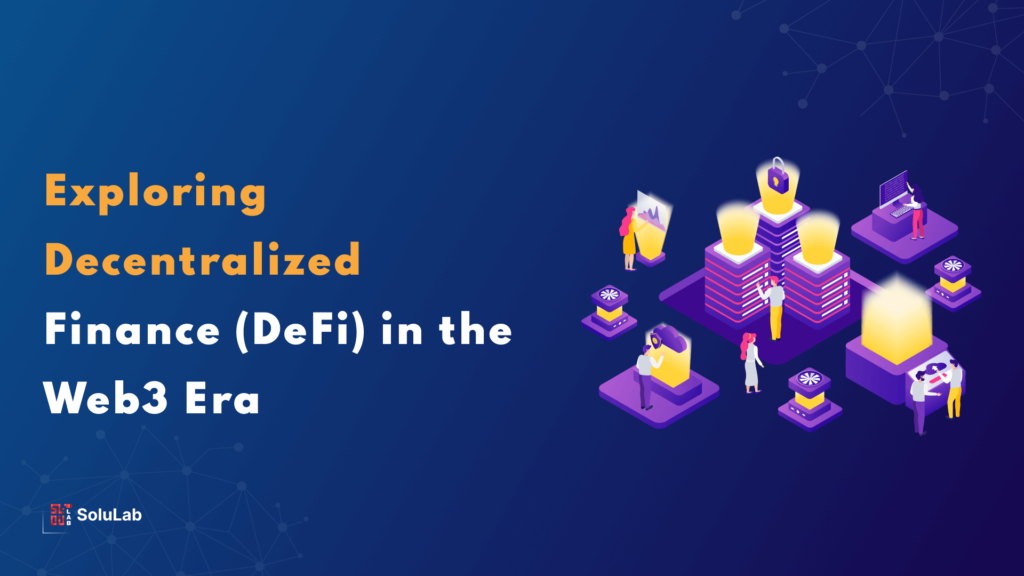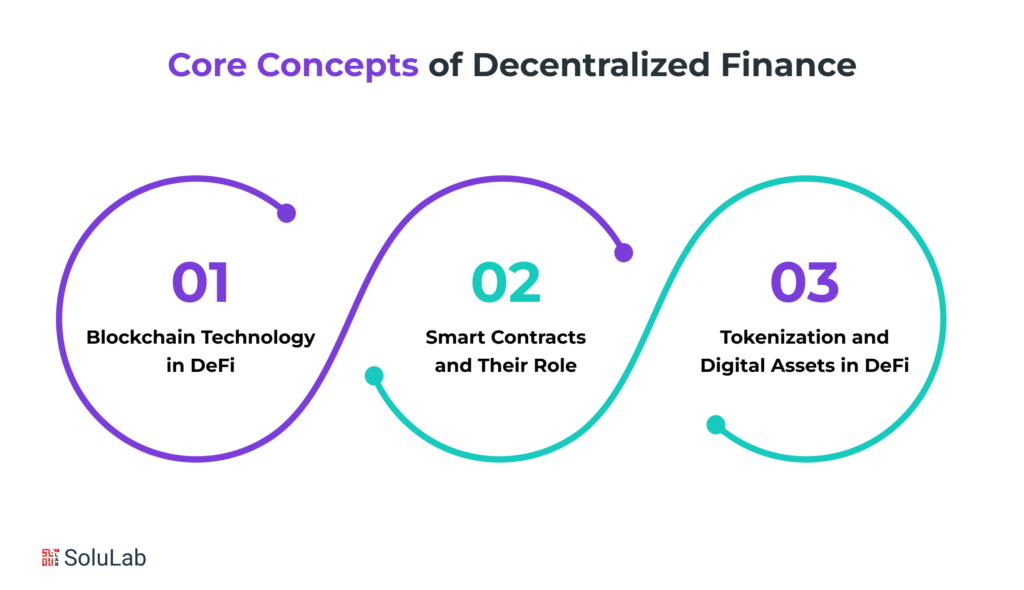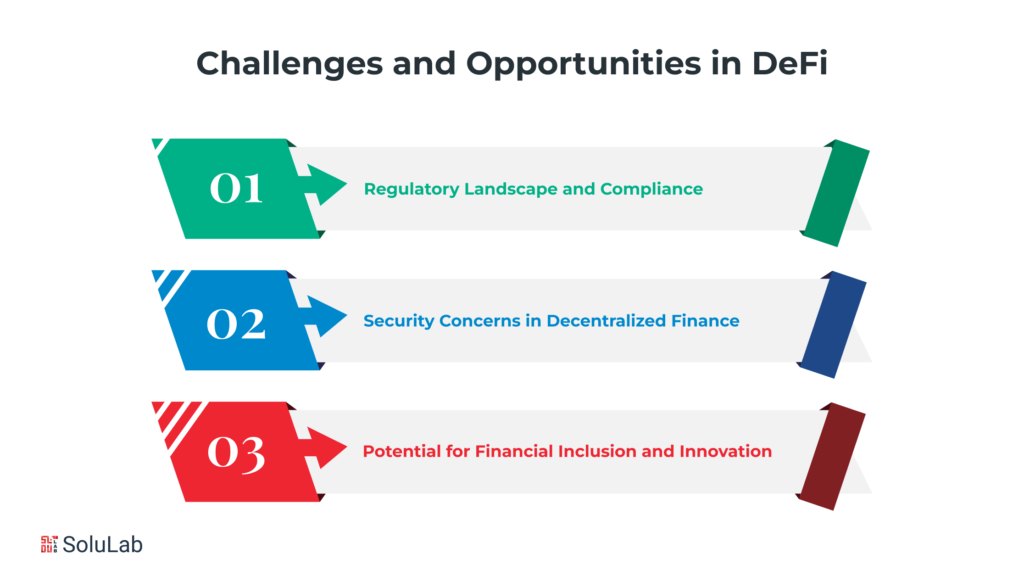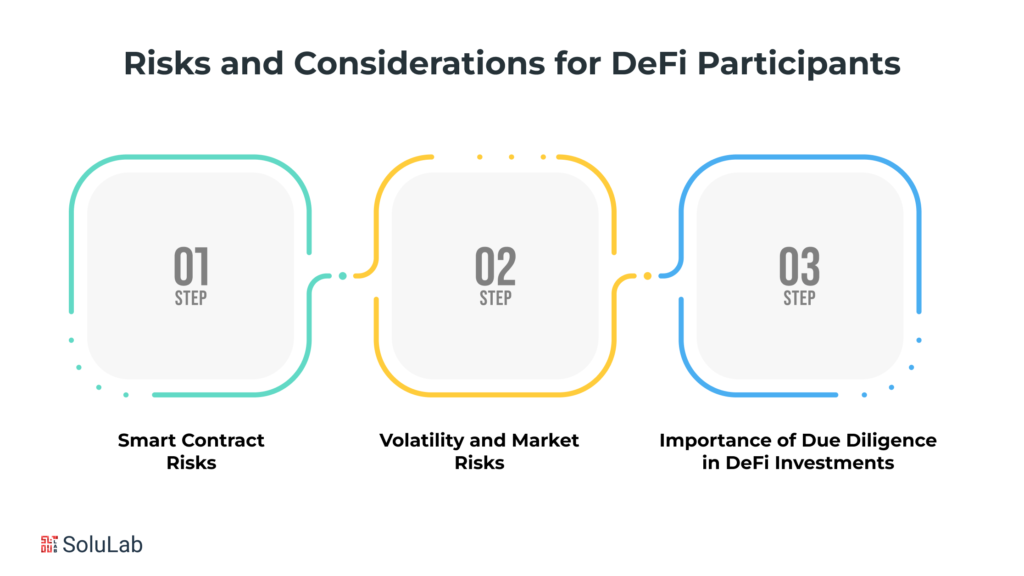
The ever-evolving landscape of financial technology has seen the emergence of Decentralized Finance (DeFi) in the Web3 era. This groundbreaking shift combines the principles of decentralization, blockchain technology, and user-centric applications to redefine the way we perceive and engage with traditional financial systems. DeFi is a new financial system that is built on decentralized networks. This means that it is not controlled by any one entity, such as a government or bank. Instead, it is controlled by the people who use it. This makes DeFi more transparent and efficient than traditional financial systems.
DeFi applications are built on blockchain technology. This is a distributed ledger technology that allows for secure, transparent, and tamper-proof transactions. Blockchain technology is also what makes DeFi possible. DeFi applications are user-centric. This means that they are designed to be easy to use and understand. They are also designed to be accessible to everyone, regardless of their financial status.
DeFi has the potential to revolutionize the financial system. It can make financial services more accessible and affordable for everyone. It can also make the financial system more transparent and efficient. DeFi is still in its early stages of development. However, it has the potential to change the way we think about and use money.
Decentralized Finance (DeFi) in the Web3 Era
At the core of this evolution is the synergy between DeFi and Web3, representing the third era of the internet. Web3 emphasizes decentralization, user empowerment, and seamless interoperability. DeFi, nestled within Web3, embodies these principles, fostering a financial ecosystem that operates transparently, inclusively, and without the constraints of traditional intermediaries. DeFi is a new financial system that uses decentralized applications (dApps) to provide financial services without the need for traditional intermediaries such as banks and brokerages. DeFi dApps are built on top of blockchains, which are distributed ledgers that allow for secure, transparent, and tamper-proof transactions.
Web3 is a new version of the internet that is built on decentralized technologies such as blockchain. Web3 aims to give users more control over their data and to make the internet more open and accessible to everyone. The synergy between DeFi and Web3 has the potential to revolutionize the financial system. DeFi dApps can provide financial services that are more efficient, transparent, and accessible than traditional financial services. DeFi in Web3 can provide the infrastructure that DeFi dApps need to operate securely and efficiently.
Understanding Decentralized Finance (DeFi)
Decentralized Finance, or DeFi, refers to a paradigm shift in the traditional financial system. It leverages blockchain technology to create an open and permissionless financial ecosystem, enabling peer-to-peer transactions without the need for traditional intermediaries like banks. DeFi platforms aim to provide inclusive and accessible financial services to a global audience.
The core principle of DeFi is decentralization, meaning there is no central authority governing these financial systems. Smart contracts, which are self-executing contracts with the terms of the agreement directly written into code, play a central role in DeFi applications. This eliminates the need for intermediaries, reducing costs, and increasing transparency.
Evolution of DeFi in the Web3 Era
The DeFi in Web3 era marks a new phase in the development of the internet, characterized by decentralized protocols and user-centric applications. DeFi plays a pivotal role in this evolution, harnessing the power of blockchain and smart contracts to create a trustless and transparent financial infrastructure. The synergy between DeFi and Web3 technologies opens new possibilities for innovation and user empowerment.
As Web3 technologies advance, they bring about enhanced security, privacy, and user control. DeFi projects built on Web3 principles aim to provide users with full ownership of their assets and data, further aligning with the decentralized ethos.
Significance of DeFi in the Current Financial Landscape
The significance of DeFi lies in its ability to democratize finance. Traditional financial systems often exclude large segments of the global population due to various barriers. DeFi, built on principles of decentralization and inclusivity, aims to address these shortcomings by providing financial services such as lending, borrowing, and trading in a permissionless and censorship-resistant manner.
In the context of Web3, where users are becoming more aware of their digital rights, DeFi aligns with the ethos of empowering individuals. It allows users to be in control of their financial activities without the need to rely on centralized entities. This shift has the potential to reshape the entire financial landscape, making it more accessible and equitable.
Core Concepts of Decentralized Finance

Delving into the core concepts of DeFi, we can unravel the intricate web of blockchain technology, smart contracts, and the role of digital assets within the DeFi framework. These foundational elements form the backbone of a decentralized financial landscape, facilitating trustless transactions, transparent processes, and novel financial instruments. Blockchain technology is a distributed ledger that records transactions in a secure and transparent manner. Smart contracts are self-executing contracts that are stored on the blockchain. Digital assets are assets that exist in digital form, such as cryptocurrencies and tokens.
DeFi uses these foundational elements to create a financial system that is not controlled by any central authority. This allows for trustless transactions, as there is no need for a third party to verify or approve transactions. DeFi also provides transparent processes, as all transactions are recorded on the blockchain. Finally, DeFi allows for the creation of novel financial instruments, such as decentralized exchange and lending platforms. DeFi is still in its early stages of development, but it has the potential to revolutionize the financial system.
-
Blockchain Technology in DeFi
Blockchain technology forms the backbone of decentralized finance. It serves as a distributed and immutable ledger, ensuring transparency and security in financial transactions. In the context of DeFi, blockchain enables the creation of smart contracts, which are self-executing contracts with predefined rules. These contracts automate various financial processes, including lending, borrowing, and trading, without the need for intermediaries.
-
Smart Contracts and Their Role
Smart contracts are the building blocks of DeFi applications. Coded to execute predefined conditions, smart contracts enable trustless and automated transactions. In DeFi in Web3, the synergy between DeFi and smart contracts becomes even more potent. Users can engage in financial activities with the assurance that the terms of the agreement will be executed precisely as coded, without reliance on centralized authorities.
-
Tokenization and Digital Assets in DeFi
Tokenization involves representing real-world assets as digital tokens on a blockchain. In the context of DeFi, this process is instrumental. Through tokenization, traditional assets like real estate or commodities can be represented as digital tokens, making them divisible and tradable on blockchain networks. This innovation enhances liquidity and accessibility, expanding the range of assets that can participate in Decentralized Finance Web3.
Key Components of the DeFi Ecosystem
A closer look at the key components of the decentralized finance (DeFi) ecosystem reveals the pivotal role played by decentralized exchange, automated market makers, and the integration of non-fungible tokens (NFTs). This dynamic ecosystem empowers users to trade directly, provide liquidity, and tokenize unique assets, amplifying the versatility and accessibility of financial services. Decentralized exchange (DEXs) allows users to trade cryptocurrencies without the need for a central authority. This is in contrast to centralized exchanges, which are typically operated by a single company or organization. DEXs are often seen as more secure and transparent than centralized exchanges, as they are not subject to the same risks of fraud or censorship.
Automated market makers (AMMs) are a type of DEX that uses algorithms to set prices for assets. This allows for more efficient trading than traditional order book-based exchanges. AMMs are also often seen as more secure than traditional exchanges, as they do not hold user funds on their own. Non-fungible tokens (NFTs) are digital assets that are unique and cannot be replicated. NFTs can be used to represent a wide variety of assets, including art, collectibles, and in-game items. NFTs are often traded on DEXs, and they can also be used to provide liquidity to AMMs.
-
Decentralized Exchanges (DEX)
decentralized exchange is a platform that facilitates the peer-to-peer trading of digital assets without the need for intermediaries. In a DEX, users retain control of their private keys and funds throughout the trading process, enhancing security. The integration of decentralized exchange within the DeFi ecosystem aligns with the overarching goal of removing central points of failure and providing users with full control over their assets.
-
Decentralized Lending and Borrowing Platforms
DeFi lending platforms enable users to lend their digital assets to others in exchange for interest or borrow assets by providing collateral. These platforms operate through smart contracts, automating the lending and borrowing processes. In the Web3 era, the decentralized nature of these platforms ensures that users have direct ownership and control over their funds, fostering trust in the lending and borrowing ecosystem.
-
Automated Market Makers (AMM) and Liquidity Pools
Automated Market Makers play a crucial role in decentralized exchange by providing liquidity through algorithmically determined pricing. Users can trade assets directly with smart contracts, and liquidity providers contribute assets to pools, earning fees in return. This innovative approach to liquidity, coupled with the decentralized nature of AMMs, enhances the efficiency and accessibility of trading within the DeFi ecosystem.
Challenges and Opportunities in DeFi

DeFi, like any other innovation, has its own set of challenges and opportunities. Regulatory considerations, security concerns, and the potential for financial inclusion and innovation all contribute to a complex landscape. Navigating this landscape requires a deep understanding of the complexities involved in order to create an environment that is conducive to responsible development. Regulatory considerations are one of the biggest challenges facing DeFi. DeFi protocols are often decentralized, which means that they are not subject to the same regulations as traditional financial institutions. This can make it difficult for DeFi protocols to comply with regulations, and it can also make it difficult for regulators to track and monitor DeFi activity.
Security concerns are another major challenge facing DeFi. DeFi protocols are often built on smart contracts, which are computer programs that run on blockchains. Smart contracts are not always secure, and there have been a number of high-profile cases of DeFi protocols being hacked. This has led to a loss of confidence in DeFi, and it has made it difficult for DeFi to attract mainstream adoption. Despite the challenges, DeFi also has the potential to revolutionize the financial system. DeFi protocols can provide financial services to people who are underserved by traditional financial institutions. DeFi can also be more efficient and less expensive than traditional financial institutions. If DeFi can overcome the challenges it faces, it has the potential to make a significant impact on the financial system.
-
Regulatory Landscape and Compliance
The decentralized nature of DeFi poses challenges in navigating regulatory landscapes. As governments and regulatory bodies grapple with the emergence of Decentralized Finance Web3, ensuring compliance becomes crucial. Striking a balance between the decentralized ethos of DeFi and regulatory requirements presents an ongoing challenge and an opportunity for the industry to mature responsibly.
-
Security Concerns in Decentralized Finance
Security is paramount in DeFi, given its reliance on smart contracts and blockchain technology. Instances of vulnerabilities and exploits have raised concerns. However, the dynamic nature of the DeFi exchanges also provides opportunities for continuous improvement. Innovations in security protocols and audits contribute to enhancing the robustness of DeFi applications.
-
Potential for Financial Inclusion and Innovation
One of the significant opportunities presented by DeFi is its potential to foster financial inclusion globally. By providing open and accessible financial services, DeFi has the capacity to reach the unbanked and underbanked populations. This aligns with the broader goals of Web3 technologies, which prioritize inclusivity and empowerment.
Real World Applications of DeFi
DeFi is not just a theoretical concept. It is already being used in real-world applications, such as traditional finance, cross-border transactions, and the tokenization of tangible assets. The adaptability of DeFi shows its potential to revolutionize industries, opening doors to new possibilities in realms ranging from traditional finance to healthcare. For example, DeFi can be used to create new financial products and services that are more efficient and accessible than traditional offerings. It can also be used to reduce costs and improve transparency in cross-border transactions. And, it can be used to tokenize tangible assets, such as real estate or gold, making them more easily tradable and accessible.
DeFi is still in its early stages of development, but it has the potential to change the way we think about finance and the way we do business. It is an exciting and innovative technology with the potential to make a real difference in the world. Navigating the DeFi landscape requires a keen understanding of the intricacies involved. DeFi protocols are complex, and it is important to understand the risks involved before investing in them. It is also important to stay up-to-date on the latest developments in DeFi, as the landscape is constantly changing.
-
DeFi in Traditional Finance
DeFi is not confined to the realm of digital assets. It has the potential to bridge the gap between traditional finance and Decentralized Finance Web3. Through tokenization and smart contracts, traditional assets can seamlessly integrate into DeFi applications, unlocking new avenues for investment and financial innovation.
-
Cross-Border Transactions and Remittances
The decentralized nature of blockchain and DeFi enables efficient and cost-effective cross-border transactions. Users can send and receive digital assets globally without the need for traditional banking infrastructure. This not only reduces transaction costs but also accelerates the speed of cross-border remittances.
-
Tokenization of Real Assets in DeFi
Real-world assets, such as real estate or art, can be tokenized and represented on blockchain networks. This opens up opportunities for fractional ownership, enabling a broader audience to invest in traditionally illiquid assets. DeFi facilitates the trading and transfer of these tokenized assets, unlocking liquidity in previously inaccessible markets.
Risks and Considerations for DeFi Participants

Participation in DeFi comes with its own set of risks and considerations. From smart contract risks to market volatility, participants must navigate potential challenges with diligence. This section sheds light on the importance of due diligence, risk management, and the evolving nature of the DeFi landscape. Due diligence is the process of investigating a project or investment before participating in it. This includes researching the project’s team, its whitepaper, and its code. It is important to do your due diligence before participating in any DeFi project, as there have been cases of scams and fraud.
Risk management is another important consideration for DeFi participants. The DeFi market is volatile, and prices can fluctuate wildly. It is important to understand the risks involved before investing in any DeFi project. Finally, the DeFi landscape is constantly evolving. New projects are being launched all the time, and the landscape is constantly changing. It is important to stay up-to-date on the latest developments in DeFi in order to make informed decisions about where to invest.
-
Smart Contract Risks
While smart contracts automate processes in DeFi, they are not immune to risks. Vulnerabilities in smart contract code can lead to exploits and financial losses. Participants in the DeFi ecosystem must conduct thorough due diligence, including code audits and reviews, to mitigate the risks associated with smart contracts. The DeFi in Web3 era emphasizes the importance of community-driven audits and transparency in addressing these challenges.
-
Volatility and Market Risks
The decentralized nature of DeFi exposes participants to market volatility. Digital assets, subject to rapid price changes, can impact the value of collateral and influence lending and borrowing dynamics. Risk management strategies, such as diversification and decentralized stablecoins, become essential in navigating the dynamic DeFi landscape within the context of DeFi in Web3.
-
Importance of Due Diligence in DeFi Investments
Participating in DeFi requires a comprehensive understanding of the projects and platforms involved. Conducting due diligence on protocols, governance mechanisms, and the security posture of DeFi applications is critical. The DeFi in Web3 ethos encourages active community engagement, empowering participants to contribute to due diligence processes and collectively enhance the robustness of the DeFi ecosystem.
Future Trends and Innovations in DeFi
In the concluding segment, we take a look into the future of DeFi. Anticipated trends, including the integration with DeFi in Web3 technologies, the role of NFTs, and the potential for decentralized identity (DID) in finance, offer a glimpse into the ongoing narrative of innovation within the decentralized financial frontier.
DeFi is a rapidly evolving field, and it is difficult to predict exactly what the future holds. However, the trends discussed in this article suggest that DeFi has the potential to revolutionize the financial industry. By integrating with DeFi in Web3 technologies, DeFi can make it easier for people to access financial services and products. NFTs can be used to represent digital assets, which could be used to create new financial products and services. Decentralized identity could make it easier for people to control their own financial data.
-
Integration with Web3 Technologies
The integration of DeFi with Web3 technologies marks a significant trend. Web3, with its focus on decentralized and user-centric applications, aligns seamlessly with the ethos of Decentralized Finance Web3. The integration enhances user experiences, interoperability, and the overall sustainability of DeFi projects.
-
NFTs (Non-Fungible Tokens) in DeFi
Non-fungible tokens (NFTs), representing unique digital or real-world assets, are gaining traction in DeFi. NFTs introduce new dimensions to Decentralized Finance Web3 by enabling the inclusion of unique assets in lending, borrowing, and trading activities. The intersection of NFTs and DeFi presents innovative opportunities for creators, investors, and users alike.
-
The Role of Decentralized Identity (DID) in Finance
Decentralized Identity (DID) solutions contribute to the evolution of DeFi by enhancing user privacy, security, and accessibility. Users can have greater control over their identity information, reducing reliance on centralized authorities. The integration of DID in DeFi aligns with Web3 principles, emphasizing user empowerment and privacy.
Conclusion
In conclusion, the exploration of Decentralized Finance (DeFi) within the Web3 era unravels a narrative that transcends the boundaries of traditional finance. This transformative journey navigates the intricacies of blockchain technology, smart contracts, and digital assets, weaving a tapestry of innovation that reshapes the financial landscape.
Navigating the DeFi ecosystem reveals key components that propel this financial revolution. decentralized exchange provides users with direct access to a variety of financial instruments, eliminating intermediaries and fostering a peer-to-peer ecosystem. Automated market makers and liquidity pools contribute to the fluidity of the market, enabling users to contribute and withdraw liquidity seamlessly. The integration of non-fungible tokens (NFTs) adds a layer of uniqueness and ownership to digital assets, expanding the scope of possibilities within DeFi.
In this narrative of innovation, SoluLab emerges as a key player, contributing significantly to the development and deployment of DeFi models. As a leading AI development company, SoluLab brings expertise, dedication, and a forward-thinking approach to the table. Whether businesses are exploring DeFi for creative endeavors or seeking innovative solutions, SoluLab’s role in this landscape is instrumental. The integration of DeFi in the Web3 era marks a significant milestone in the evolution of financial systems. The collaboration between decentralized principles, blockchain technology, and user-centric applications signifies not just a departure from traditional norms but a leap toward a future where financial empowerment is truly decentralized. The road ahead holds promises of innovation, challenges to be conquered, and a financial landscape where SoluLab continues to shine as a beacon of expertise and forward-thinking in the realm of Decentralized Finance Web3
Embarking on this journey has been a revelation—a testament to the resilience and adaptability of financial systems in the face of technological disruption. As we turn the page, let us carry the lessons learned and the visions glimpsed into the future, where Decentralized Finance in the DeFi in Web3 era becomes not just a concept but a lived reality for all.
FAQs
1. What is decentralized finance?
Decentralized finance, often abbreviated as DeFi, refers to the ecosystem of financial applications and services built on blockchain technology. In a decentralized finance system, traditional financial intermediaries are replaced or augmented by smart contracts on blockchain platforms, promoting transparency, accessibility, and inclusivity.
2. How does DeFi align with Web3?
DeFi aligns with Web3 by embodying principles of decentralization, user empowerment, and interoperability. Web3, the third era of the internet, emphasizes decentralized protocols and user-centric applications. DeFi leverages blockchain and smart contracts to create a financial landscape that aligns with the ethos of Web3.
3. What role does a decentralized exchange play in DeFi?
A decentralized exchange (DEX) is a crucial component of DeFi, allowing users to trade digital assets directly without relying on centralized intermediaries. Defi DEX platforms facilitate peer-to-peer trading through smart contracts, enhancing security, reducing counterparty risk, and promoting a trustless environment within the DeFi ecosystem.
4. What are the key applications of DeFi?
DeFi applications are diverse and cover areas such as lending, borrowing, decentralized exchange, liquidity provision, and more. These applications provide financial services without traditional intermediaries, offering users access to a global and permissionless financial ecosystem.
5. How are NFTs integrated into DeFi?
Non-fungible tokens (NFTs) are integrated into DeFi by representing unique digital or real-world assets on blockchain networks. In the context of DeFi, NFTs can be used as collateral, traded on decentralized exchange, or utilized in various financial instruments. This integration adds a layer of uniqueness and innovation to DeFi protocols.






